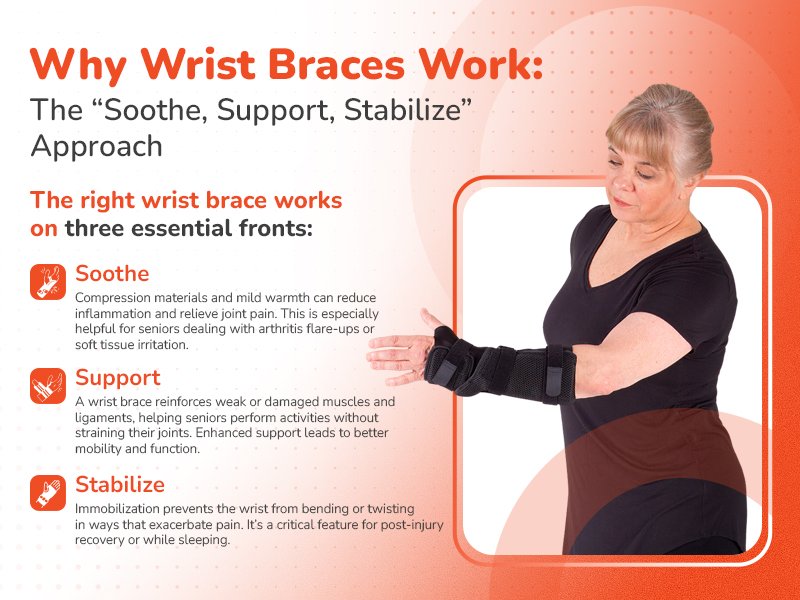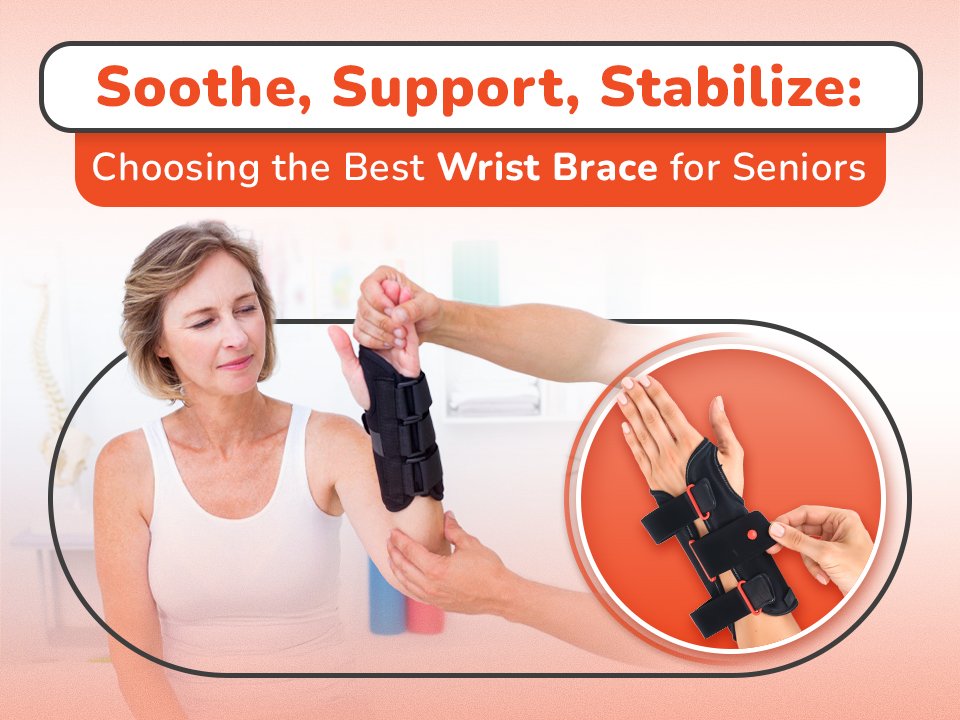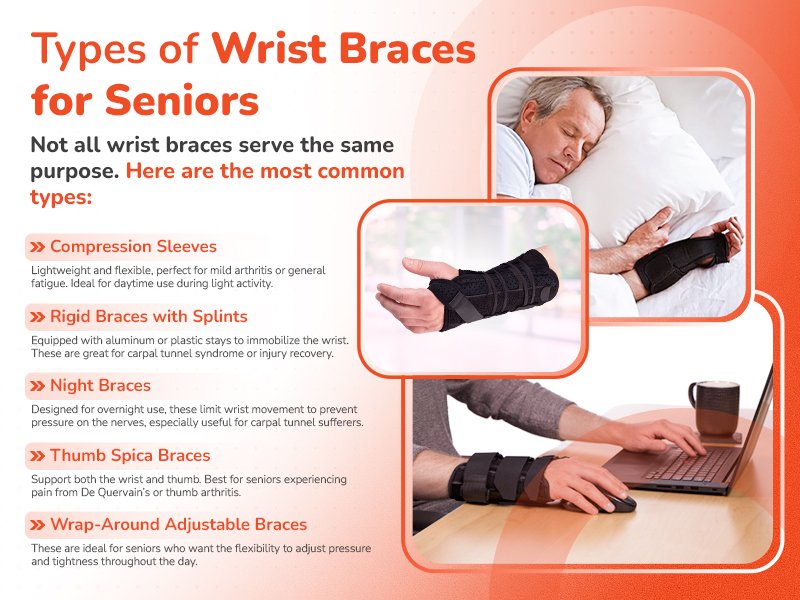Introduction
With age comes wisdom—and often, joint pain. One of the most common complaints among seniors is discomfort in the wrists, especially during everyday activities like writing, cooking, or lifting light objects. Whether caused by arthritis, tendon inflammation, or repetitive strain, wrist pain can significantly limit independence and quality of life.
Thankfully, wrist braces offer a simple yet powerful solution. They soothe inflammation, support weak joints, and stabilize wrist movement. But not all braces are made the same, and finding the best wrist brace for seniors requires thoughtful consideration of comfort, effectiveness, and daily usability.
In this guide, we’ll explore how to choose a wrist brace that delivers all three—soothe, support, and stabilize—along with tips on types, fit, use, and care.
Understanding Wrist Pain in Seniors
Wrist pain in older adults is more than an occasional nuisance—it can stem from long-standing wear-and-tear or underlying health conditions that require targeted management.
Common Causes of Wrist Pain Among Seniors
- Osteoarthritis – Degenerative cartilage loss in the wrist joint, leading to stiffness and aching.
- Carpal Tunnel Syndrome – Compression of the median nerve, resulting in numbness, tingling, or weakness.
- Rheumatoid Arthritis – An autoimmune condition that inflames joints and can deform wrists.
- Tendonitis – Inflammation of tendons due to repetitive strain or overuse.
- Sprains or Minor Fractures – Often related to falls, which are more frequent in aging populations.
- Post-surgical recovery – Seniors healing from procedures may require additional support to regain function.
For conditions like carpal tunnel syndrome, proper support can greatly reduce discomfort and slow symptom progression.
Why Wrist Braces Work: The “Soothe, Support, Stabilize” Approach
The right wrist brace works on three essential fronts:
1. Soothe
Compression materials and mild warmth can reduce inflammation and relieve joint pain. This is especially helpful for seniors dealing with arthritis flare-ups or soft tissue irritation.
2. Support
A wrist brace reinforces weak or damaged muscles and ligaments, helping seniors perform activities without straining their joints. Enhanced support leads to better mobility and function.
3. Stabilize
Immobilization prevents the wrist from bending or twisting in ways that exacerbate pain. It’s a critical feature for post-injury recovery or while sleeping.

What to Look for in a Senior-Friendly Wrist Brace
Choosing the right brace is essential for comfort, compliance, and effectiveness. Here’s what seniors and caregivers should prioritize:
1. Adjustability
The brace should have Velcro or wrap-around straps that can accommodate swelling or changes in joint size during the day.
2. Soft, Breathable Materials
Seniors often have sensitive skin. Choose hypoallergenic, latex-free fabrics that prevent irritation.
3. Ease of Use
Choose a brace that’s easy to put on and remove without assistance. Seniors with limited dexterity benefit from one-handed wrap-style designs.
4. The Right Level of Support
Mild compression sleeves are great for everyday use, while rigid braces with metal stays may be needed for more severe conditions.
5. Size and Fit
Proper sizing is crucial. A brace that’s too tight can cut off circulation, while a loose one offers no support.
Heal Medical Supply’s wrist braces are thoughtfully designed to meet these exact needs, offering a range of sizes and support levels for everyday comfort and medical relief.
Types of Wrist Braces for Seniors
Not all wrist braces serve the same purpose. Here are the most common types:
1. Compression Sleeves
Lightweight and flexible, perfect for mild arthritis or general fatigue. Ideal for daytime use during light activity.
2. Rigid Braces with Splints
Equipped with aluminum or plastic stays to immobilize the wrist. These are great for carpal tunnel syndrome or injury recovery.
3. Night Braces
Designed for overnight use, these limit wrist movement to prevent pressure on the nerves, especially useful for carpal tunnel sufferers.
4. Thumb Spica Braces
Support both the wrist and thumb. Best for seniors experiencing pain from De Quervain’s or thumb arthritis.
5. Wrap-Around Adjustable Braces
These are ideal for seniors who want the flexibility to adjust pressure and tightness throughout the day.
Each design serves a unique purpose, and some seniors even benefit from owning more than one type—one for rest, one for activity.
Daily Benefits of Wrist Braces for Older Adults
A wrist brace isn’t just a temporary fix. With consistent use, it can improve everyday comfort, independence, and mental well-being.
Key Daily Benefits Include
- Pain Reduction from arthritis and joint inflammation
- Improved Grip Strength for opening jars, lifting objects, and writing
- Better Sleep by limiting painful wrist movements overnight
- Injury Prevention through motion restriction during risky tasks
- Increased Confidence in mobility and hand use
- Posture Correction by keeping the wrist in an anatomically safe position
- Drug-Free Pain Relief, an essential benefit for seniors managing multiple medications
A study by the NIH supports the long-term use of wrist braces in elderly patients with chronic joint pain.
How to Wear a Wrist Brace Correctly
Wearing your wrist brace the right way ensures comfort, stability, and pain relief. Follow these simple tips to get the best results:
- Clean, dry skin:
Always start with clean, dry skin to prevent irritation. Avoid applying lotion under the brace. - Proper fit:
Secure the straps so the brace feels snug but not too tight. It should stay in place without cutting off circulation. - Align splints correctly:
If your brace has a built-in splint, make sure it rests under your wrist—not on top or off-center—for maximum support. - Wear at the right time:
Use the brace during pain flare-ups or repetitive tasks like typing, lifting, or cooking. Nighttime use may help with carpal tunnel symptoms. - Take breaks:
If wearing the brace all day, remove it occasionally to allow your wrist to stretch and stay active.
Care and Maintenance for Long-Term Use
Keeping your wrist brace clean and in good condition helps extend its lifespan and ensures safe use.
- Wash weekly:
Hand wash with mild soap and lukewarm water. Avoid bleach or machine washing. - Air dry completely:
Let the brace dry flat in a shaded area. Don’t use dryers or heaters, as heat can damage the materials. - Spot clean between washes:
Wipe with a damp cloth to remove dirt and sweat after daily use. - Store in a dry place:
Keep your brace in a cool, ventilated spot away from moisture or heat to avoid mold and odor. - Inspect monthly:
Check for worn-out Velcro, loose stitching, or damage. Replace if the brace no longer fits or functions properly.
Regular cleaning prevents bacterial infections, especially important for seniors with sensitive skin.
When to Replace Your Wrist Brace
Wrist braces should be replaced when they no longer provide effective support. Watch for these signs:
- The brace slips, feels too loose, or won’t stay in place
- Fabric or straps are torn, stretched, or cracked
- Velcro closures don’t hold
- Persistent odor even after washing
- New or worsening pain while wearing it
- You’ve had a medical update that requires a different type of brace
If you’re unsure, speak with a medical provider or contact Heal Medical Supply for help selecting the right replacement.
Conclusion
Wrist pain doesn’t have to interfere with an active, independent lifestyle. The right wrist brace can make a world of difference by soothing pain, supporting joint health, and stabilizing movement. Whether managing arthritis, carpal tunnel syndrome, or general aging-related weakness, seniors can benefit from daily use of a thoughtfully designed brace.
When choosing your brace, prioritize comfort, adjustability, and support—and be sure to follow daily care and wear tips for optimal results.
Heal Medical Supply’s wrist braces are Medicare-eligible and trusted by seniors across the country. Our team is ready to help you find the perfect fit for your needs.
Need help selecting the right brace? Contact us today to speak with a specialist and take the next step toward wrist pain relief and confidence in every movement.







